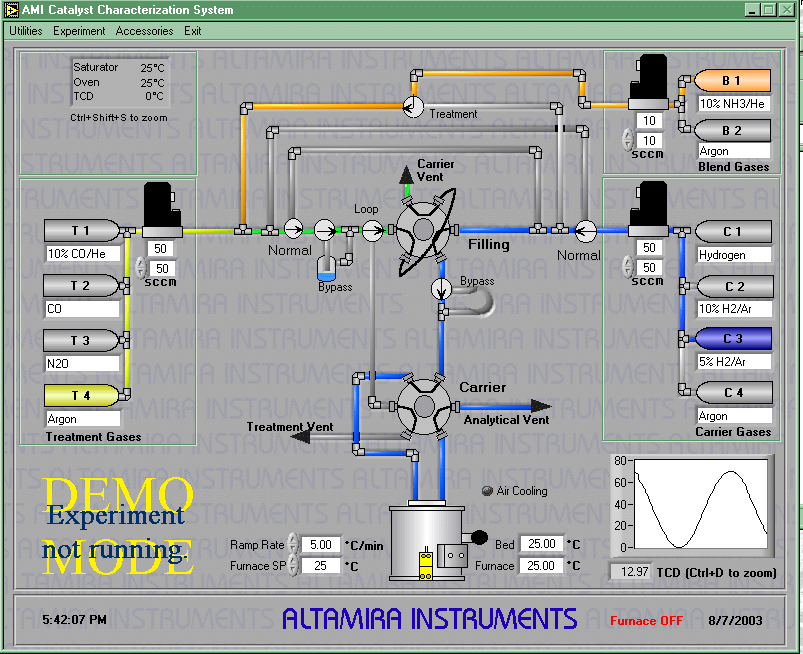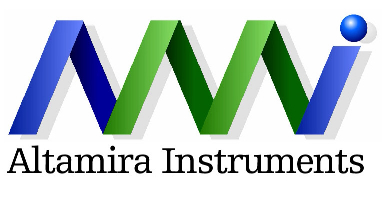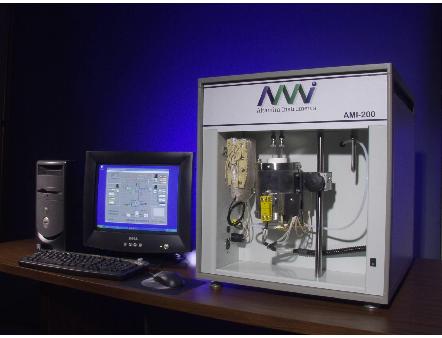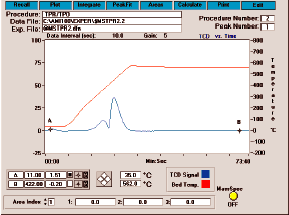|
Operating Screen — A complete overview
of all experimental parameters:

Choice of
Detectors
The AMI-200 comes standard with a thermal conductivity detector. An
integrated mass spectrometer and a flame ionization detector are also
available. Any other detector that provides ananalog ouput or can communicate
with a PC can be integrated.
Gas Blending
Capabilities
The AMI-200 comes standard with gas blending capabilities, obviating any need
to purchase expensive gas blends to conduct experiments such as TPR or TPO.
The AMI-200 includes an auxiliary gas line by means of which a third gas can
be mixed with the carrier gas to provide custom-blended gases. A low volume,
in-line static gas mixer assures homogeneity of the resulting blend. The gas
blending capability also facilitates the use of the AMI-200 as a gas-phase,
atmospheric reactor.
Our Expertise
Altamira was founded by catalyst researchers. We understand your
requirements. Our experts are available to answer your questions and help in
your applications.
We will be happy to customize a system to meet your exact needs. Some
customizations which we have undertaken include: a separate pre-treatment
station controlled by the computer; addition of liquid feeds for use of the
instrument as a reactor; incorporation of methanizer to a flame ionization
detector; design of a system dedicated to oxygen storage capacity (OSC);
modification to permit fast changes in feed composition, as fast as 1 Hz, for
aging studies.
Specifications:
• Catalyst Charge: 0.1 – 1.0 grams
• Temperature Range: -100°C to +1200°C with Subambient Option
• 30°C/minute standard (Other Ramp Rates Available)
• Operating Pressure: Atmospheric
• Gases: 4 carrier, 4 treatment, 2 auxiliary (Others Available)
• Gas Flow Rates: 5 to 50 sccm (Others Available)
• Reactor Types: Quartz U-tubes, Bubble Tubes, Monolith Tubes (up to
1" diameter)
• Primary Detectors: 4 filament TCD with choice of material (W, Au/W)
• Materials of Construction: Flow path: 316 stainless steel
• Seals: Viton, Buna-N, or Premium Seals (depending on customer
chemical compatibility requirements)
• Dimensions: 56 cm (W). 60 cm (H), 61 cm (D)
• Weight: approximately 55 kg (120 lbs)
• Power Requirements: 110-120 or 220-240 Volts, single phase, 50 or 60
Hz. 15 amp service
• Computer Specifications: Pentium IV processor, 1.2 GHz (minimum), 256
MB RAM, 30 GB Hard Drive Windows XP
AMI-200 Features
Seven (7) Standard Procedures - Pulse chemisorption, TPR/TPO, TPD,
TPRx, treatment, pulse calibration, and flow BET.
Ability to link 99 procedures into one experiment.
Three Independent Gas Sources - In addition to a carrier gas and a
treatment gas, the AMI-200 provides one additional
independently controlled auxiliary gas inlet which can be blended with the
carrier gas.
Ten (10) Gas Ports - Gas ports located on the back of the instrument
minimizes the time expended changing gases. Four ports
each for treatment and carrier gases. Two ports are available for gas
blending or auxiliary gases. Additional ports can be added.
Electronic Flow Controllers - Unit uses high quality linear mass flow
controllers to display and control gas flows. Flow rate span is 0-50 Sccm
(standard). Other ranges are available upon request.
Interchangeable Valve Loops - Provide an easy way to reach the
appropriate level of sensitivity for different samples.
Liquid Vaporizer - Unit is equipped with a heated sparger-type
saturator for easy introduction of volatile liquids.
High Temperature Furnace - Temperature up to 1200ºC; with
sub-ambient cooling, the lower limit is -80ºC. Furnace can be linearly
ramped from 1ºC/min to 30ºC/min.
Air Cooling - Cools the furnace rapidly for quick sample turn around.
Sample Temperature - Measured by a moveable thermocouple placed at the
top of the sample bed.
Various Sample Holders - Unit accommodates a variety of quartz U-tubes
sized to accommodate various catalyst volumes and sizes: straight, bubble,
preheat, monolith. Samples may be powders, pellets, extrudates or honeycomb
cores.
Easy Sample Loading - A movable furnace allows easy removing and
loading of the sample holder.
Trap - A trap that may be filled with a desiccant or used as a cold
trap is provided downstream of the sample holder in order to remove
condensables before the TCD.
Heated Null Station - Ensures accurate calibration pulses without
contact with the sample.
Injection
Port - A syringe
injection port is provided for exact loop volume calibration.
Heated Lines - All lines, valves, and parts of the liquid vaporizor
are heated to prevent condensation.
Thermal Conductivity Detector - Highly reliable 4-filament TCD used to
quantify gas uptakes. Excellent linearity, accuracy, sensitivity, and
stability. Several filament options are available.
Direct Mass Spectrometer Link - Ametek's MS data can be integrated in
real-time with AMI-200 data using DDE.
Auxiliary Detectors - Can accept any auxiliary detector providing a
voltage analog output, such as a flame ionization detector (FID).
Low Internal Volume - Low volume valves and 1/16” lines are used
to reduce void volume and minimize peak spreading.
Materials of Construction - Seals and materials are custom engineered
to meet your specifications.
Safety Features - Among others: independent over-temperature protectors
for furnace, resealable pressure relief valves, check valves, circuit
breakers, and fuses. System is designed to fail in safe mode.
|



